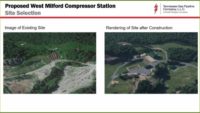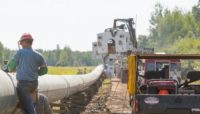Oral arguments are set for March 7 in a Tucson federal court related to a new lawsuit by Arizona Tribal Nations and environmental groups to reverse federal government approval of a construction restart on the $11-billion SunZia transmission project.
In the suit filed in January, plaintiffs want work halted on 50 miles of the 550-mile, high-voltage direct-current (HVDC) line between central New Mexico and south-central Arizona until all historic and cultural properties in the latter state's San Pedro River Valley are identified and evaluated. The project, developed by San Francisco-based Pattern Energy Group LP, would connect to a massive, yet-to-be-built wind energy project in New Mexico and would bring 3,000 MW of power to Western states.
The U.S. Interior Dept. halted construction in mid-November over the tribal concerns but allowed affected work to resume Nov. 29.
Quanta Infrastructure Services Group is engineering, procurement and construction contractor for the transmission line, with Hitachi Energy as HVDC supplier and Blattner Energy, a Quanta unit, as EPC contractor for the wind project. GE Vernova and Vestas are supplying more than 900 wind turbines.
The complaint was filed in U.S. District Court by the Tohono O’odham Nation, the San Carlos Apache tribe, the Center for Biological Diversity and Archaeology Southwest.
Plaintiffs claim the department violated the National Historic Preservation Act by not properly consulting tribes about the valley’s cultural and historic significance, with 12,000 years of claimed human activity. It is considered one of the most intact prehistoric landscapes in southern Arizona. Archaeology Southwest identified more than 500 archaeological sites at risk.
Tribes say they asked federal officials in 2009, when the project was first announced, to consider valley sites as “traditional cultural places” and find a less harmful route.
“Since 2009, the SunZia transmission team has actively worked with [the government] and participating tribes to identify and address any impacts to cultural resource properties,” says Natalie McCue, Pattern Energy assistant vice president of environmental and permitting, in an email to ENR. Respecting tribal sovereignty and completing the largest U.S. clean energy project "is not a binary choice," she adds.
But McCue adds that time has passed to reconsider the route, approved in 2015.
"We were saddened by the decision to pursue legal action, especially given our commitment to open, good-faith dialogue on these vital issues," she says. "We remain committed to advancing the SunZia project, having engaged in a nearly decade-long collaborative and inclusive consultation process."
Notice to proceed and right-of-way authorization were issued early last fall. Construction began in the San Pedro Valley on Sept. 26 that included grading, site clearing and placement of heavy equipment in sensitive areas, the complaint says.
"We have plenty of room to move and work with our client [on other parts of the project than the contested section]," Quanta Services CEO Earl C. Austin told investors on Feb. 22. "We’re not concerned. The project starts now, [and] ramps [up] throughout the year."
Pattern Energy says the wind project and line completion is set for 2026. SunZia is expected to create more than 2,000 construction jobs and have a $20.5-billion economic impact on the region, the firm says
Interior officials declined comment on the litigation.






Post a comment to this article
Report Abusive Comment